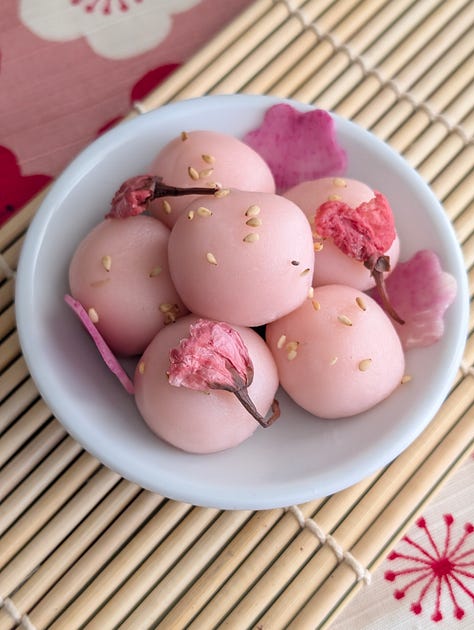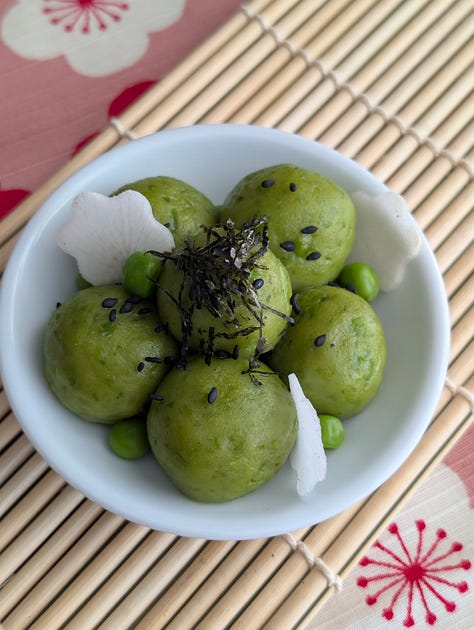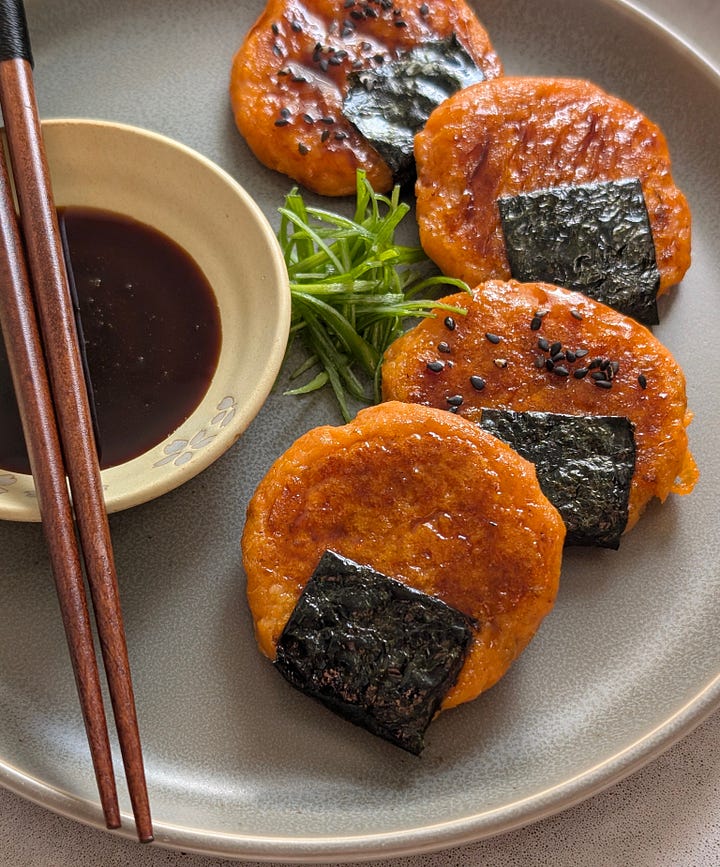Mochi, But Make It Savory
a guide to savory, snackable mochi
I blame my early days as a cake lady for always seeing the world through rosy, buttercream-colored lenses, because when I hear the word mochi, my mind immediately goes to soft, pillowy mounds of sweetness. I imagine those dreamy domes filled with red bean paste, a juicy bit of fruit, or even ice cream.
At least, that used to be the case.
A few months ago, I tumbled down a social media foodie rabbit hole, mesmerized by anime-inspired food recreations. More specifically, I went down the Demon Slayer-style potato mochi rabbit hole. Video after video showed golden-brown potato patties sizzling in a pan, glazed with a glossy, sweet-savory sauce. Some were wrapped in nori, others oozed with cheese. The ASMR alone was enough to hypnotize. I was sold. And I wondered—what other cool things could one do with mochi?
The internet rarely disappoints.
I came across a stunning plate of savory carrot mochi, served in a modern, elegant way. This impressive mochi was pan-seared, sprinkled generously with pistachio dukkah and served up gnocchi-style. My mind and tastebuds raced. If mochi could be made with carrots, what else could be mochi-fied?
Unlike dessert mochi, which often requires starting with a dough that needs to be cooked, rolled out, and molded around a sweet filling, savory mochi is surprisingly simple. If you have sweet glutinous rice flour (mochiko), you’re halfway there. The simple dough begins with a mashed base ingredient that provides flavor and structure mixed with glutinous rice flour and a bit of salt. You really don’t even need a recipe! (But I’ll give you two anyway so you have a place to start!)
From there, you have two cooking options:
Poaching in hot water creates a bouncy, chewy texture similar to gnocchi.
Pan-searing results in a crispy golden exterior while keeping the inside soft and tender.
Both methods are easy, and both deliver a texture that’s uniquely satisfying.
So, what exactly can you mochi? If it can be mashed, chances are it can be mochi-fied. Potatoes and sweet potatoes are obvious choices, but here are a few other options:
Carrots
Spring peas
Beets
Parsnips
Pumpkin
The list definitely doesn’t stop there. (If you’ve got an idea, I’d love to hear what you’d mochi-fy first!)
My Mochi Experiments
Since we’re approaching spring, I wanted to play with a pink, white, and green color palette, drawing inspiration from hanami (cherry blossom viewing) and seasonal Japanese flavors.
After making each batch, I added a few extra touches and served them with a simple dipping sauce. Here’s how they turned out:
Pink: Inspired by sakura (cherry blossom) rice balls, I mixed cherry blossom powder into mashed potatoes for a soft, floral note. I garnished with sesame seeds, pickled cherry blossoms, and pink radishes.
White: Made with leftover white potatoes, these are a dressed-up version of my Potato Mochi Balls recipe. Instead of tossing them in the sauce, I served it on the side as a dip and sprinkled the mochi with furikake, crispy fried onions, and scallions.
Green: A labor of love! I peeled the outer hulls of peas for a smooth-ish dough. The ones I missed left just enough texture for a pleasant bite. These were dressed with black sesame seeds, white radish, and a few whole peas for contrast.



Savory Mochi Recipes
The recipes I’m providing both use glutinous rice flour. Despite the name, it contains no gluten. Made from sticky rice, this flour is prized for its high starch content, which gives mochi its signature chew and elasticity. Unlike regular rice flour, which lacks this stretchiness, glutinous rice flour binds into a soft, pliable dough that transforms into bouncy, tender mochi when cooked. It’s an essential ingredient, and there’s really no substitute—using regular rice flour just won’t achieve the same texture.


For home cooking, Mochiko is the most accessible option. It’s fine and powdery, dissolves easily, and is commonly found in grocery stores.
Now, let’s get this (mochi) ball rolling. Here are two basic recipes to get you started and give you the chance to try both cooking methods.
Potato Mochi Balls are gently poached in hot water, yielding a pillowy chew similar to gnocchi.
Carrot Mochi are pan seared in the skillet for a lightly crisped exterior and a smooth, soft bite inside.
Feel free to use these as a starting point for customizing your own mochi. Keep in mind that if it can be mashed, it can most likely be mochif-ied!
Cook Along with Me—Live!
If you’re loving the idea of creative plant-based cooking, join me live on Sunday, March 30 for a free Vegan Bento Box Cooking Class with Chef Adam Sobel of Cinnamon Snail! This interactive, live-streamed class will guide you through crafting a delicious, artfully arranged plant-based bento box from your own kitchen.







This is just the unique and fun read I needed this afternoon! It's all so beautiful. I'll have to put this on my list to try as my kids love mochi and so a dinner of mochi would most definitely put me on their favs list.
Oh this looks good. I’m traveling now but this is on my list to try as soon as I get home. Yum!